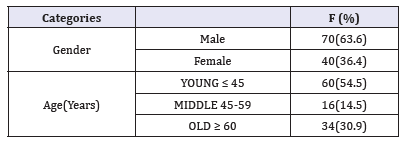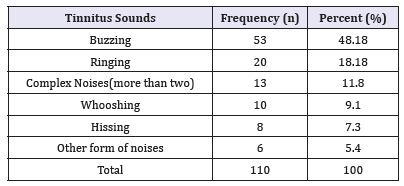- Submissions

Full Text
Experiments in Rhinology & Otolaryngology
Tinnitus and Perception of Differing Noise Sensations: A Survey of Patient Experiences in Pakistan
Ammar Ahmed* and Muhammad Aqeel
Department of Psychology, Foundation University, Islamabad
*Corresponding author: Ammar Ahmed, Department of Psychology, Foundation University, Islamabad
Submission: April 04, 2018Published: August 14, 2018

ISSN 2637-7780 Volume2 Issue2
Abstract
The objective of this study was to review the roles of gender, age and differing perceptions of tinnitus, among male and female Pakistani tinnitus patients. The data consisted of 110 Tinnitus Patients (Male Tinnitus Patients n=70, Female Tinnitus Patients n=40). Purposive sampling technique was used based on cross-sectional design. Data was collected from various hospitals of Pakistan, through complete otorhinolaryngological (ear) examination. Tinnitus Handicap Inventory (THI) was employed to measure perception of tinnitus along with coping strategies used by Pakistani tinnitus patients. The results suggested that overall tinnitus levels do not differ between genders in tinnitus; however males reported more tinnitus complaints and females are more influenced by anxiety than males. Also the severity of tinnitus varies according to the tinnitus sensations experienced. Typically avoidance coping is also used more often by tinnitus patients. Recommendations of the study are that both male and female tinnitus patients can get more benefit by addressing the tinnitus complaints. It would be helpful for health and clinical setting to resolve the psychological and health issues of male and female patients according to the nature of tinnitus severity and sensation.
Introduction
Tinnitus is a regular illness in the global population Andersson G & McKenna 2005 [1]. Various studies with diverse age groups, have estimated prevalence of tinnitus is between 10% to 15% [2- 4]. Few researches have reported observations that the occurrence of tinnitus increases with age [5,6]. Gender differences related to tinnitus have been observed in many studies previously [7] specifically, women are more expected to report complaints about tinnitus than men. Consequently, there are many studies on tinnitus that demonstrate a slightly higher occurrence in females [8,9].
The occurrences were greater in females less than the age of 40 years, whereas tinnitus prevalence was very much common in males between the ages of 40 and 70 years in other studies [10]. The reason given is that men are usually more exposed to noises such as the use of firecrackers, firearms (Guns in the military), and exposure to noisy work environments like drilling etc. On the other hand, women are more severely disturbed by their tinnitus [11-14].
Materials and Methods
Purposive sample of 110 tinnitus patients was taken from E.N.T & Audiology Department of Hearts International Hospital, Rawalpindi and Alam Audiology Clinic, Shadman, Lahore. This study included 70 Male and 40 Female tinnitus patients age ranged from 18 to 90 Years the average age of patients was 45.89(SD=19.06) having the tinnitus symptom for at least 2-3 months. All patients had been assessed by a doctor for ear related diseases; afterwards complete audio logical test (consisting of air-bone measurements, audiometric values, middle-ear pressure, acoustic reflexes, and compliance) was performed to assess the hearing loss and tinnitus symptoms. This study was approved by the Institutional Review Board of the Foundation University Psychology Department and E.N.T Clinic (FURC/2018 No. F-1101-001-001). Written informed consent was obtained from all participants prior to the survey.
Procedure
Participants attended E.N.T & Audiology Departments of Hearts International Hospital, Rawalpindi and Alam Audiology Clinic, Shadman, Lahore and gave informed consent prior to the inclusion into the study. They completed a single assessment of approximately 25minutes duration. This included completing medical history, measures including hearing evaluation and tinnitus related questionnaire was administered. Ear examination was performed using a Welch Allyn™ otoscope. Audiometric and tinnitus assessments were performed via Interacoustic AA-222 Clinical Audiometer. The Transducers used for air conduction thresholds were TDH-39P headphones for audiometry. Bone conduction thresholds were noted by using Type B-71 bone vibrator, placed on the mastoid bone of the test ear (Table1). Tympanometry was performed wherever essential for middle ear examination using the Interacoustic Middle Ear Analyzer. Calibration of instruments was in compliance with the international guidelines and had IEC 60645- 1/ANSI S.3.6 standards. Audiometric and tinnitus related data were gathered in an approved sound-treated room.
Table 1:Demographics of the Sample (N=110)

Results
Participants (70%) with self-reported symptoms of tinnitus specified a single type of sensation (like: ringing or buzzing). Buzzing was significantly reported single sensation with 48.18% of the participants reporting it, Ringing (12.4%), after that a combination of two or more than two sounds like buzzing along with ringing; or whooshing along with hissing; or humming, and, roaring, beeping, and buzzing etc; adding up to a total of 11.8%, whooshing 9.1%, hissing 7.3%, and other 5.4%. Sounds that were explained as white noise and crickets crooking etc were specifically placed in the ‘‘other’’ category because of their rarity (Table 2).
Table 2:Description of tinnitus sounds

Conclusion
Patients with tinnitus undergo a variety of psychological and functional distress as a result of their tinnitus symptoms. This study demonstrates the complexity of tinnitus for those patients having buzzing sensation the foremost reported symptom (48.18%) following the sensations of ringing and complex noises experienced by the patients leading them towards functional difficulties and using avoidant behaviors. Although there are a few audiological services for patients with tinnitus in Pakistan, many people find it difficult to access these care diagnostic services. Many of those discharged from the diagnostic centers are not successfully cured for the psychological trauma specially the younger population due to stigmatization of a psychiatric diagnosis in most cases. Even with psychological treatment modalities having the finest evidence base for successful tinnitus management, only a minority of tinnitus patients ever get to meet a psychologist, specially the younger age group in Pakistan. Recommendations include empiricallysupported therapies such as ACT and CBT, for emotional distress and functional impairments.
References
- Shokry S, Al Sayed AH, Zidan MF, Hafez AA, Abdulsalam HM (2012) Avoiding mastoid cavity problems: Mastoid obliteration using bio-active glass. The Egyptian Journal of Hospital Medicine 47: 321-333.
- Yung M, Tassone P, Moumoulidis I, Vivekanandan S (2011) Surgical management of troublesome mastoid cavities. J Laryngol Otol 125(3): 221-226.
- Sarin J, Grénman R, Aitasalo K, Pulkkinen J (2012) Bioactive glass S53P4 in mastoid obliteration surgery for chronic otitis media and cerebrospinal fluid leakage. Ann Otol Rhinol Laryngol 121(9): 563-569.
- Vartiainen E (2000) Ten-year results of canal wall down mastoidectomy for acquired cholesteatoma. Auris Nasus Larynx 27(3): 227-229.
© 2018 Ammar Ahmed. This is an open access article distributed under the terms of the Creative Commons Attribution License , which permits unrestricted use, distribution, and build upon your work non-commercially.
 a Creative Commons Attribution 4.0 International License. Based on a work at www.crimsonpublishers.com.
Best viewed in
a Creative Commons Attribution 4.0 International License. Based on a work at www.crimsonpublishers.com.
Best viewed in 







.jpg)





























 Editorial Board Registrations
Editorial Board Registrations Submit your Article
Submit your Article Refer a Friend
Refer a Friend Advertise With Us
Advertise With Us
.jpg)






.jpg)













.bmp)
.jpg)
.png)
.jpg)














.png)

.png)



.png)






